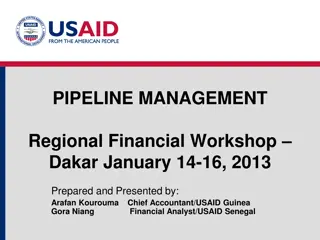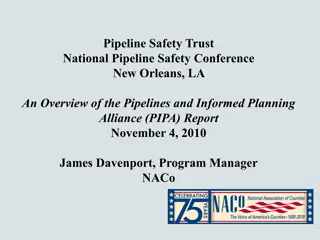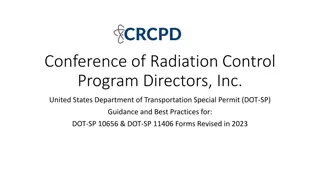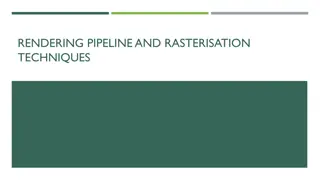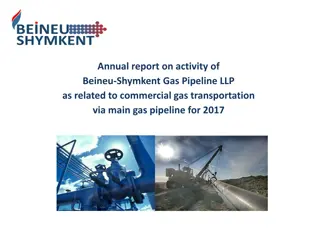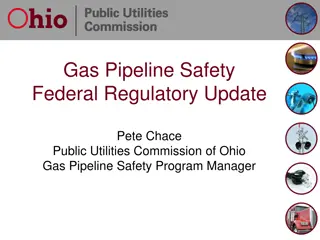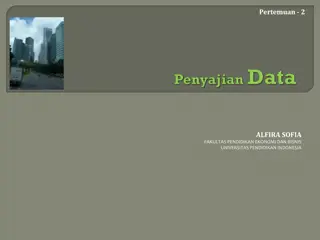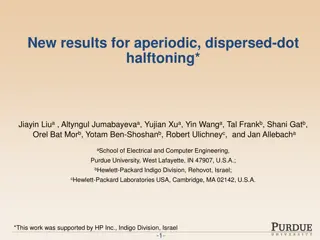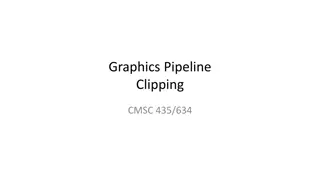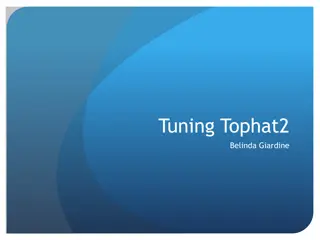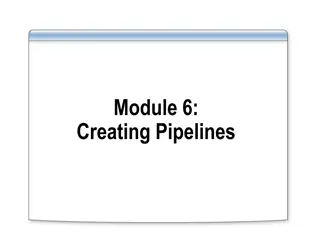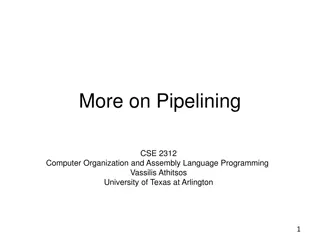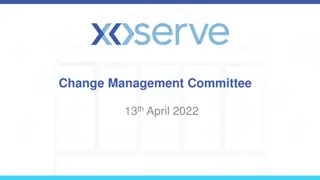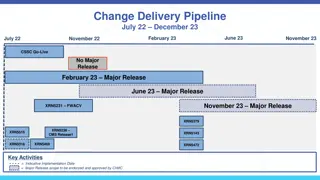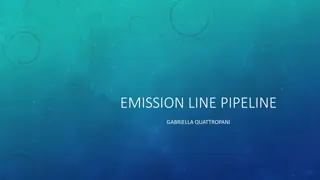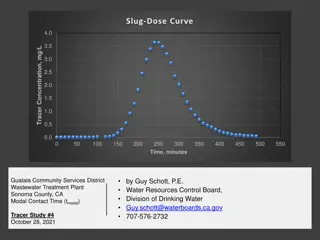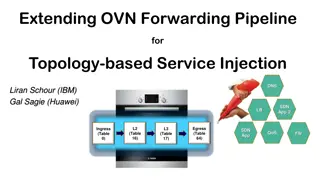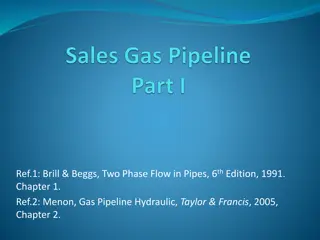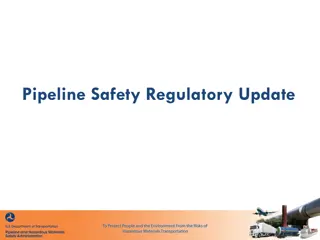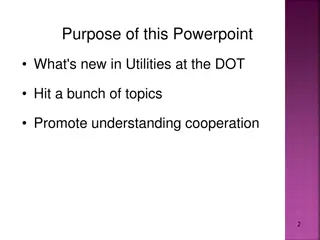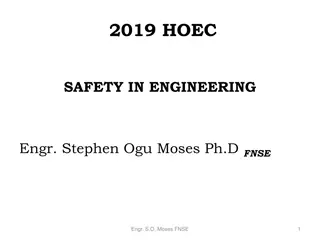Understanding Pipeline Safety Regulations by U.S. DOT
Explore the detailed information provided by the U.S. Department of Transportation's Pipeline and Hazardous Materials Safety Administration on gas gathering, transmission, and distribution lines. Learn about current regulations, definitions, and key considerations for ensuring pipeline safety in the industry.
Download Presentation

Please find below an Image/Link to download the presentation.
The content on the website is provided AS IS for your information and personal use only. It may not be sold, licensed, or shared on other websites without obtaining consent from the author. Download presentation by click this link. If you encounter any issues during the download, it is possible that the publisher has removed the file from their server.
E N D
Presentation Transcript
U.S. Department of Transportation Pipeline and Hazardous Materials Safety Administration Gas Gathering Update Pipeline Safety Getting to Zero Pipeline Safety Trust Annual Conference New Orleans, Louisiana November 17, 2011 John A. Jacobi, P.E. CATS Manager, SW Region Pipeline and Hazardous Materials Safety Administration
U.S. Department of Transportation Pipeline and Hazardous Materials Safety Administration OUTLINE Definitions (49 CFR Part 192) Current Regulations (Onshore) Type A lines Type B Lines Issues Possible Rulemaking Questions
U.S. Department of Transportation Pipeline and Hazardous Materials Safety Administration Gathering Line A pipeline that transports gas from a current production facility to a transmission line or main.
U.S. Department of Transportation Pipeline and Hazardous Materials Safety Administration Transmission Line Transmission line means a pipeline, other than a gathering line, that: 1)Transports gas from a gathering line or storage facility to a gas distribution center, storage facility, or large volume customer that is not down-stream from a gas distribution center;
U.S. Department of Transportation Pipeline and Hazardous Materials Safety Administration Transmission Line (continued) Transmission line means a pipeline, other than a gathering line, that: 2)operates at a hoop stress of 20 percent or more of SMYS; or 3)transports gas within a storage field.
U.S. Department of Transportation Pipeline and Hazardous Materials Safety Administration Distribution Line A pipeline other than a gathering or transmission line.
U.S. Department of Transportation Pipeline and Hazardous Materials Safety Administration Production Operation Piping and equipment used for production and preparation for transportation or delivery of [gas] including the following: a) Extraction and recovery, lifting, stabilization, treatment, separation, production processing, storage and measurement of [gas]; and or transmission line.
U.S. Department of Transportation Pipeline and Hazardous Materials Safety Administration Production Operation Piping and equipment used for production and preparation for transportation or delivery of [gas] including the following: b) Associated production compression, gas lift, gas injection, or fuel gas supply. (API Recommended Practice 80)
U.S. Department of Transportation Pipeline and Hazardous Materials Safety Administration Simple definition Gathering starts where production ends and ends when transmission starts. The devil is in the details!!
U.S. Department of Transportation Pipeline and Hazardous Materials Safety Administration Current Regulations March 2006 Final Rule: Onshore Gas Gathering Uses American Petroleum Institute Recommended Practice 80 (API RP 80) as the basis for defining an onshore gathering line, with additional limitations.
U.S. Department of Transportation Pipeline and Hazardous Materials Safety Administration Current Regulations Type A Regulated Onshore Gas Gathering Lines Metallic lines with a maximum allowable operating pressure (MAOP) of 20% or more of specified minimum yield strength (SMYS), as well as nonmetallic lines with an MAOP of more than 125 psig, in a Class 2, 3, or 4 location.
U.S. Department of Transportation Pipeline and Hazardous Materials Safety Administration Current Regulations Type A Regulated Onshore Gas Gathering Lines Subject to all of the requirements for transmission lines, except for the accommodation of smart pigs in new and replaced lines and the gas integrity management requirements. Permitted to use an alternative process for complying with the operator qualification requirements
U.S. Department of Transportation Pipeline and Hazardous Materials Safety Administration Current Regulations Type B Regulated Onshore Gas Gathering Lines Metallic lines with an MAOP of less than 20% of SMYS, as well as nonmetallic lines with an MAOP of 125 psig or less, in a Class 2 location (as determined under one of three formulas) or in a Class 3 or Class 4 location.
U.S. Department of Transportation Pipeline and Hazardous Materials Safety Administration Current Requirements Type B Regulated Onshore Gas Gathering Lines Any new or substantially changed Type B line must comply with the design, installation, construction, and initial testing and inspection requirements for transmission lines and, if of metallic construction, the corrosion control requirements for transmission lines
U.S. Department of Transportation Pipeline and Hazardous Materials Safety Administration Current Requirements Type B Regulated Onshore Gas Gathering Lines Operators must include Type B lines within their damage prevention and public education programs, establish the MAOP of those lines under 192.619, and comply with the line marker requirements for transmission lines.
U.S. Department of Transportation Pipeline and Hazardous Materials Safety Administration CAVEAT Neither Type A nor Type B Regulated Onshore Gas Gathering Lines are regulated in Class 1 areas (offshore areas or rural areas where there are 10 or fewer buildings intended for human occupancy within 220 yards on either side of the centerline of any continuous 1-mile segment of pipeline)
U.S. Department of Transportation Pipeline and Hazardous Materials Safety Administration
U.S. Department of Transportation Pipeline and Hazardous Materials Safety Administration Issues API RP 80 was not created for the purpose of regulation and contains conflicting and ambiguous language PHMSA s intended regulatory constraints contain editorial flaws Operator misuse of ambiguous language in RP has allowed some circumvention of intended regulation in populated areas
U.S. Department of Transportation Pipeline and Hazardous Materials Safety Administration Risk Basis The 2006 rulemaking was based on the premise that gathering lines were small diameter/low energy lines Eliminated political boundaries as method for determining which gathering was regulated Used Class location criteria (Class 2, 3, & 4)
U.S. Department of Transportation Pipeline and Hazardous Materials Safety Administration Risk Basis Shale developments don t fit that risk analysis 8 -30 diameter 1480# MAOP 2 14 wells located on 1-2 acre sites
U.S. Department of Transportation Pipeline and Hazardous Materials Safety Administration Gas Gathering installed in Fort Worth area since 2005
U.S. Department of Transportation Pipeline and Hazardous Materials Safety Administration Risk Basis Tiered Structure Type A = MAOP >20% SMYS Subject to transmission requirements minus IM OQ light in class 2 Type B Compliance activities directly targeted at incident causes presented by GPA at 02/04 TPSSC
U.S. Department of Transportation Pipeline and Hazardous Materials Safety Administration Regulated vs. Non-Regulated Year Number of Operators Onshore Mileage (regulated) 2005 1483 16,033 2009 327 - 378 20,150 Estimated total onshore mileage - 171,628 miles of non-regulated onshore gas gathering as reported by GPA at 02/04 TPSSC GPA membership = 40 companies Does not include non-regulated mileage operated by the approx 7,000 member companies of IPAA (Independent Pet Assn of Amer)
U.S. Department of Transportation Pipeline and Hazardous Materials Safety Administration NAPSR Resolutions Extend reporting requirements to all onshore gas gathering ( 06) Add leak survey requirements to Type B regulated ( 06) PHMSA modify 49 CFR Part 192.8 and 192.9 to establish regulatory requirements for gathering lines in Class 1 areas operating above 20% SMYS to be regulated as Type A gathering lines (xx) = Year resolution adopted
U.S. Department of Transportation Pipeline and Hazardous Materials Safety Administration NAPSR Resolutions PHMSA modify 49 CFR Part 192.8 and 192.9 to establish regulatory requirements for all gathering lines in Class 1 areas to be subject to 49 CFR Part 192.614 and 192.707 in order to minimize damage from 3rd party excavation; and PHMSA modify 49 CFR Part 192.8 and 192.9 to clarify its intent to establish a risk based regulation for the section of piping identified as incidental gathering in API RP 80. ( 10) (xx) = Year resolution adopted
U.S. Department of Transportation Pipeline and Hazardous Materials Safety Administration Possible Rulemaking Subject all onshore gas gathering to the reporting requirements contained in 49 CFR Part 191 (satisfy #1 NAPSR resolution and collect data for future decisions) Develop and codify definitions for production and gathering Eliminate reference to API RP 80
U.S. Department of Transportation Pipeline and Hazardous Materials Safety Administration Possible Rulemaking Address editorial issues regarding end of gathering in Part 192.9 (satisfy #3 NAPSR resolution) Add leak survey requirements to Type B (satisfy #2 NAPSR resolutions) Require OQ
U.S. Department of Transportation Pipeline and Hazardous Materials Safety Administration Questions John A. Jacobi, P.E. 713-272-2839 (O) 281-685-7128 (C) john.jacobi@dot.gov - 28 -


